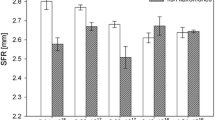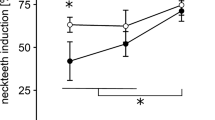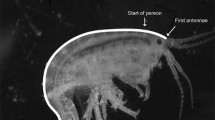Summary
Numerous adaptive predator-induced responses occurred when eight clones representing seven Daphnia (Crustacea: Cladocera) species were tested against three common predators: fourth instar larval phantom midge Chaoborus americanus, adult backswimmer Notonecta undulata, and small sunfish Lepomis macrochirus. The predators were confined within small mesh bags, suggesting that the signal for induction is chemical. The induced responses included longer tail spines, longer heads, smaller bodies, increased egg clutches, and decreased lipid reserves. Each Daphnia species responded to each of the three predators in a unique manner. Induced responses in the above characters showed no significant association. The induced morphological changes are generally consistent with current theories of what is an adaptive response for the various sizes of Daphnia exposed to tactile and visual predators. The abundance of induced responses in these experiments suggests that predator-induced responses are a widespread and ecologically important phenomenon of the freshwater zooplankton.
Similar content being viewed by others
References
Balcer MD (1988) Ecology of the crustacean zooplankton and young-of-the-year rainbow smelt populations of western Lake Superior. Chapter 3: Observations on the feeding behavior of young rainbow smelt. Ph.D. thesis. University of Wisconsin, Madison, Wisconsin, USA, p 83
Dodson SI (1974) Adaptive change in plankton morphology in response to size-selective predation: A new hypothesis of cyclomorphosis. Limnol Oceanogr 19:721–729
Dodson SI (1988a) Cyclomorphosis in Daphnia galeata mendotae Birge and D. retrocurva Forbes as a predator-induced response. Freshwat Biol 19:109–114
Dodson SI (1988b) The ecological role of chemical stimuli for the zooplankton: Predator-avoidance behavior in Daphnia. Limnol Oceanogr 34 (in press)
Dodson SI, Egger DL (1980) Selective feeding of red phalaropes on zooplankton of arctic ponds. Ecology 61:755–763
Dodson SI, Havel JE (1988) Indirect prey effects: Some morphological and life history responses of Daphnia pulex exposed to Notonecta undulata. Limnol Oceanogr vol. 33, W. T. Edmondson special celebratory issue. (in press)
Gilbert JJ (1980) Further observations on developmental polymorphism and its evolution in the rotifer Brachionus calyciflorus. Freshwat Biol 10:281–294
Green J (1960) Seasonal polymorphism in Scapholeberis mucronata (O.F. Muller) (Crustacea: Cladocera). J Anim Ecol 32:425–539
Havel JE (1987) Predator-induced defenses: A review. In Predation: Direct and indirect impacts on aquatic communities. Kerfoot WC, Sih A (eds) New England Press. Hanover, New Hampshire, pp 263–278
Havel JE, Dodson SI (1987) Reproductive costs of Chaoborus-induced polymorphism in Daphnia pulex. Hydrobiology 150:273–281
Hebert PDN, Grewe PM (1985) Chaoborus-induced shifts in the morphology of Daphnia ambigua. Limnol Oceanogr 30:1291–1296
Hrbacek J (1959) Circulation of water as a main factor influincing the development of helmets in Daphnia cucullata Sars. Hydrobiologia 13:170–185
Hutchinson GE (1967) A treatise on limnology. Volume 2. Wiley, New York, p 1115
Jacobs J (1962) Light and turbulence as co-determinants of relative growth rates in cyclomorphic Daphnia. Int Rev Ges Hydrobiol 47:146–156
Krueger DA, Dodson SI (1981) Embryological induction and predation ecology in Daphnia pulex. Limnol Oceanogr 23:219–223
Lampert W, Wolf HG (1986) Cyclomorphosis in Daphnia cucullata: morphometric and population genetic analysis. Journal of Plankteon Research 8:289–303
Sokal RS, Rohlf EJ (1981) Biometry. second edition. Freeman and Company, San Francisco, California, p 776
Tessier AJ, Goulden CE (1982) Estimating food limitation in cladoceran populations. Limnol Oceanogr 27:707–717
Woltereck R (1909) Weitere experimentelle Untersuchungen über Artwanderung, speziell über das Wesen quantitativer Artunterschiede bei Daphniden. Ver Deutsch Zool Gesell 1909:110–172
Author information
Authors and Affiliations
Rights and permissions
About this article
Cite this article
Dodson, S.I. The ecological role of chemical stimuli for the zooplankton: predator-induced morphology in Daphnia . Oecologia 78, 361–367 (1989). https://doi.org/10.1007/BF00379110
Received:
Issue Date:
DOI: https://doi.org/10.1007/BF00379110




